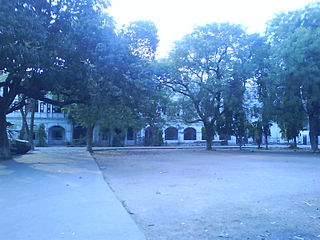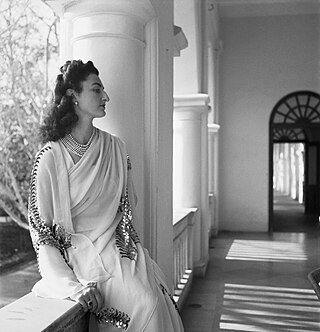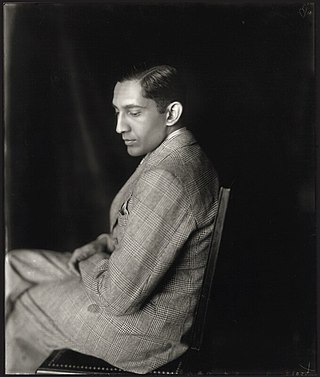
Hyderabad State was a princely state in the south-central Deccan region of India with its capital at the city of Hyderabad. It is now divided into the present-day state of Telangana, the Kalyana-Karnataka region of Karnataka, and the Marathwada region of Maharashtra in India.

Nizam of Hyderabad was the title of the ruler of Hyderabad State. Nizam is a shortened form of Niẓām ul-Mulk, and was the title bestowed upon Asaf Jah I when he was appointed Viceroy of the Deccan by the Mughal Emperor Farrukhsiyar. In addition to being the Mughal Viceroy (Naib) of the Deccan, Asaf Jah I was also the premier courtier of the Mughal Empire until 1724, when he established an independent realm based in Hyderabad, but in practice, continued to recognise the nominal authority of emperor.

Asaf Jah VI, also known as Sir Mir Mahboob Ali Khan Siddiqi, was the sixth Nizam of Hyderabad. He ruled Hyderabad State, one of the princely states of India, between 1869 and 1911.

Mir Osman Ali Khan, Asaf Jah VII was the last Nizam (ruler) of Hyderabad State, the largest state in the erstwhile Indian Empire. He ascended the throne on 29 August 1911, at the age of 25 and ruled the State of Hyderabad between 1911 and 1948, until the Indian Union annexed it. He was styled as His Exalted Highness (H.E.H) the Nizam of Hyderabad, and was widely considered one of the world's wealthiest people of all time. With some estimates placing his wealth at 2% of U.S. GDP, his portrait was on the cover of Time magazine in 1937. As a semi-autonomous monarch, he had his mint, printing his currency, the Hyderabadi rupee, and had a private treasury that was said to contain £100 million in gold and silver bullion, and a further £400 million of jewels. The major source of his wealth was the Golconda mines, the only supplier of diamonds in the world at that time. Among them was the Jacob Diamond, valued at some £50 million, and used by the Nizam as a paperweight.

Purani Haveli, also known as Masarrat Mahal palace, is a Haveli located in Hyderabad, Telangana, India. It was the official residence of the Nizam. It was also known as Haveli Kadeem, which means old mansion, was constructed for Sikander Jah, Asaf Jah III (1803–1829) by his father Ali Khan Bahadur, Asaf Jah II.

Chowmahalla Palace or Chowmahallat is the palace of the Nizams of Hyderabad State located in Hyderabad, Telangana, India. It was the seat of power of the Asaf Jahi dynasty (1720-1948) and was the official residence of the Nizams during their reign. Presently the palace is converted into a museum but the ownership still lies with the family.

Hatice Hayriye Ayşe Dürrüşehvar Sultan, after marriage Durru Shehvar Durdana Begum Sahiba, Princess of Berar; was an Ottoman princess, the only daughter of the last caliph Abdulmejid II, who was the last heir apparent to the Ottoman Imperial throne and the last Caliph of the Ottoman Caliphate.

Nizam Mir Barkat Ali Khan Siddiqi Mukarram Jah, Asaf Jah VIII, less formally known as Mukarram Jah, was the titular Nizam of Hyderabad between 1967 and 1971. He was the head of the House of Asaf Jah until he died in 2023.

Nilüfer Hanımsultan;, nicknamed as the Kohinoor of Hyderabad, was an Ottoman princess. She was the first wife of Moazzam Jah, the second son of Mir Osman Ali Khan, the last Nizam of Hyderabad in India.
Manolya Onur, Princess Qhabl Begum Sahiba Manolya-i-Nur was a Turkish model and beauty pageant titleholder who won Miss Turkey 1976 and represented her country at Miss Universe 1976. She became a princess of Berar by marriage.

The Jewels of the Nizams of Hyderabad State are among the largest and most expensive collection of jewels in present-day India. The jewels belonged to the Nizams, rulers of Hyderabad State. After the annexation of their kingdom by Union of India, the Nizam and his heirs were barred by the Indian government from taking the collection, claiming that it was a national treasure. After much litigation, the diamond was purchased by the Government of India from the Nizam's trust for an estimated $13 million in 1995, along with other jewels of the Nizams, and is held at the Reserve Bank of India vaults in Mumbai.

The Asaf Jahi was a Muslim dynasty that ruled the Hyderabad State. The family came to India in the late 17th century and became employees of the Mughal Empire. They were great patrons of Indo-Persian culture, language, and literature, and the family found ready patronage.

His Excellency Amir e Paigah Basheerd-Ud-daula Azam-Ul-Umra Amir-e-Akbar Nawab Sir Muhammad Mazharuddin Khan Bahadur Rifa’at Jang, commonly known as Sir Asman Jah or Nawab Sir Asman Jah Bahadur, Asman Jah was one of those fortunate individuals to whom it has been given by fate to write their names large in the annals of their country, he was an Indian noble and member of the Great Paigah Family who served as Prime Minister of Hyderabad from 1887 to 1894. As the grandson of the premier noble Fakhr Uddin Khan Amir e Kabir Shams-ul-Umra I and of a princess of the blood, his social position was a great one; but the personal qualities he possessed, inherited largely from his grandfather, were unquestionably the means of bringing him to the front. Singularly gifted by nature as far as the outward man was concerned and excelling in all manly pursuits, he easily took the lead among his peers. But it was his mental and moral equipment which attracted the notice of his royal master while yet the young noble was in early manhood. Such was the promise he showed that His Highness the Afzal-ud-Daulah gave him his daughter in marriage and bestowed on him the highest distinction in his gift, the title of Jah.in 1869, Asman Jah entered on his public career as Minister of Justice. A little later on, while still retaining the portfolio of Justice, he acted as prime minister and co-regent. Later still he became a Member of the Council of Regency, and finally in 1887 he was appointed prime minister and continued to hold the office till 1893. In this connection it may be noted that throughout his long official career, Sir Asman Jah refused to take any salary while willing to take office he steadily persisted im refusing the emoluments of office. Elis regime as Premier was marked by several reforms, notably the advance made in education, the extension of medical aid by the State, especially aid to women, and the establishment of a permanent Board of Irrigation and city water supply, which has since been of excellent service to the State, Asman Jah was still in London when he got the news of his having been-appointed Prime Minister and one of the first to congratulate him on his appointment was his late Majesty King Edward VIL, then Prince of Wales, Asman Jah built several architectures throughout the city like Asman Garh Palace, Basheer Bagh Palace, saroonagar palace and Mahboob Chowk Clock Tower. Just before he was appointed to the premiership he was deputed by His Highness the late Nizam, Mahboob Ali Khan, to proceed in 1887 to London as his representative at the Golden Jubilee of Her late Majesty Queen Victoria. While in England he won golden opinions by the tact, savoir faire and high breeding he displayed His handsome presence, imposing address and polished manners impressed all classes of English Society and he became a great favourite in court circles. Indeed, the late Nizam could not have had a more dignified or worthier representative.

Moazzam Jah, Walashan Shahzada Nawab Mir Sir Shuja’at ‘Ali Khan Siddiqui Bahadur, KCIE, was the son of the last Nizam of Hyderabad, Osman Ali Khan, Asaf Jah VII and his first wife Azamunnisa Begum.

Muffakham Jah Nawab Walashan Sahebzada Mir Karamath Ali Khan Siddiqi Bayafendi Bahadur is a member of House of Asaf Jah. He is the son of Prince Azam Jah and Dürrüşehvar Sultan. He is the grandson of both Osman Ali Khan, the seventh and final Nizam of the erstwhile Hyderabad princely state, and Abdulmejid II, the last Ottoman caliph.
Princess Esra Birgen is a Hyderabadi Noble from Turkey, who was once married to Crown Prince Mukarram Jah, the Head of the House of Asaf Jah of the Kingdom of Hyderabad
Nizam Mir Muhammad Azmet Ali Khan, Asaf Jah IX, known as Azmet Jah, is the current head of the House of Asaf Jah and claims the title of Nizam of Hyderabad and Berar since 20 January 2023, though the government of India has not recognised such titles since 1971.

The history of Telangana, located on the high Deccan Plateau, includes its being ruled by the Satavahana Dynasty, the Kakatiya Dynasty (1083–1323), the Musunuri Nayaks (1326–1356), the Delhi Sultanate, the Bahmani Sultanate (1347–1512), Golconda Sultanate (1512–1687) and Asaf Jahi dynasty (1724–1950).
Nawab Mir Najaf Ali Khan is a grandson of the last Nizam of Hyderabad, Mir Osman Ali Khan and is a prominent figure known for heritage conservation, social initiatives, and legal representation of the Nizam's family.

Murchison House Station is a pastoral lease that once operated as a sheep station but now rears cattle and goats in Western Australia.















